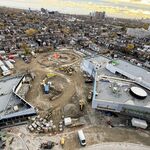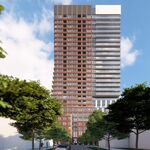W. K. Lis
Superstar
From this link, they say
I'm making an assumption, that it will be NOT like this, from this link:
This is what I think we will get instead:

at the Mt. Dennis Station.There will be secure indoor bike parking at this station.
I'm making an assumption, that it will be NOT like this, from this link:
Bicycle parking at Rotterdam Central Station
It was built in 22 months, the underground bicycle parking facility at Rotterdam’s new Central Railway Station. It was opened in November 2013 and it has parking spaces for 5,190 bicycles.
Making it the largest of the country (to date), at just a bit bigger than the runner-up. The majority of the parking spaces can be used completely free of charge.
The entrance to the large underground bicycle parking facility at the square right in front of Rotterdam Central Station and the cycleway leading to it.
This is one of several very large parking facilities that were opened in recent years at main intercity railway stations in the Netherlands. I have shown you examples of Haarlem (2010; 5,020 spaces) and Utrecht (2014; 4,200 spaces) before. Groningen (2007; 4,150 spaces) also has a facility of a similar size.
But even relatively small towns have large facilities. Houten (2011; 3,000 spaces) is a prime example and the “bicycle apple” in Alphen a/d Rijn (2010; 1,000 spaces) also shows that the Dutch arrive by bicycle at their railway stations in very high numbers. On average in the entire country 40% of the train travellers arrive by bicycle so combining modes of travel is very common in the Netherlands. That makes it necessary for the authorities to facilitate parking all those bicycles. All these large facilities popping up around the country is not because there is a race going on to have the best or biggest facility. No, building all this is needed to face an immediate and very real bicycle parking challenge.
Festivities at Rotterdam Central Station square when the king officially opened the railway station. (13th March 2014; picture courtesy of Luke Harley.) The entrance to the bicycle parking facility is clearly visible to the left.
This facility in Rotterdam was built as part of the complete reconstruction of Rotterdam Central Station and its surroundings that was finished in 2014. The Railway Station was festively opened on 13[SUP]th[/SUP] March 2014 by King Willem-Alexander. So the bicycle parking facility was opened 4 months before the rest of the station was. It has a guarded part that you can use for a fee and an unguarded part that may be used free of charge. Electronic sensors in every single parking space detect every bike and that makes it possible that the number of available spaces per row of racks is indicated. The sensor also registers how long a bicycle has been parked and if that period exceeds one month the bicycle will be removed. The impounded bicycles are collected and you can get them back for a fee. This is to make sure people do not abandon their bicycles which would fill up the facility with unused bicycles.
The interior of the Rotterdam bicycle parking facility. Rows and rows of double stacked bicycle parking racks.
The entire facility is only one floor, so the size and thus the distances are considerable. For that reason the design is such that you can and may cycle inside the facility. Mirrors make sure people cycling can see each other, even around the corner, so that collisions can be avoided. In the video you can see that people cycle in a very moderate speed to also make sure accidents don’t happen.
A system of coloured and numbered paths make sure you find your way easily. On top of that the racks are also individually numbered and the handles of the top racks are also coloured, to make it even more easy to find your bicycle back. Using the top racks requires no real muscle power because a hydraulic system in every rack helps you lift the bicycle.
The main entrance has a number of so-called travelators (moving walkways) that make it very easy to get your bicycle underground.
The travelators (moving walkways) to enter the new facility are so easy to use that a child can do it. This whole family is about to park their bikes.
The space is brightly lit to enhance the feeling of social safety. But especially compared to the Utrecht facility this facility is clearly lacking daylight. Since the ceiling of this facility forms the station square right on top of it, I think it is a missed opportunity that no windows were added to get more daylight in. A positive point is that the ceiling is high enough to park bicycles with children’s seats attached to them in the top racks.
On this rendering the roof of the facility is opened up so you can see the exact location right in front of the main hall of Rotterdam central station (drawn transparent as well). It also gives you an idea of how big it is. To the right is the tram station and to the far left the bus station. Note the absence of private motorised traffic. It can only pass the station in the front. (Picture courtesy Jan van Helleman)
The guarded part of the bicycle parking facility has a bicycle repair workshop and this is also where you can hire an OV-Fiets, the nationwide shared bicycle system of the Netherlands. But ‘normal’ bikes can also be rented and there are lockers. It was clearly visible that the free part of the facility was used more intensively than the guarded part that requires a fee. Even though the fee is not so high, at €1.25 per day. An annual subscription will cost you € 103.=
The facility offers a direct underground access to the metro station and also to the railway station. With this new facility the station square is now completely free of parked bicycles and it looks great.
[video=youtube;zWESiQlmOC0]https://www.youtube.com/watch?v=zWESiQlmOC0[/video]
This is what I think we will get instead:
Attachments
Last edited:











